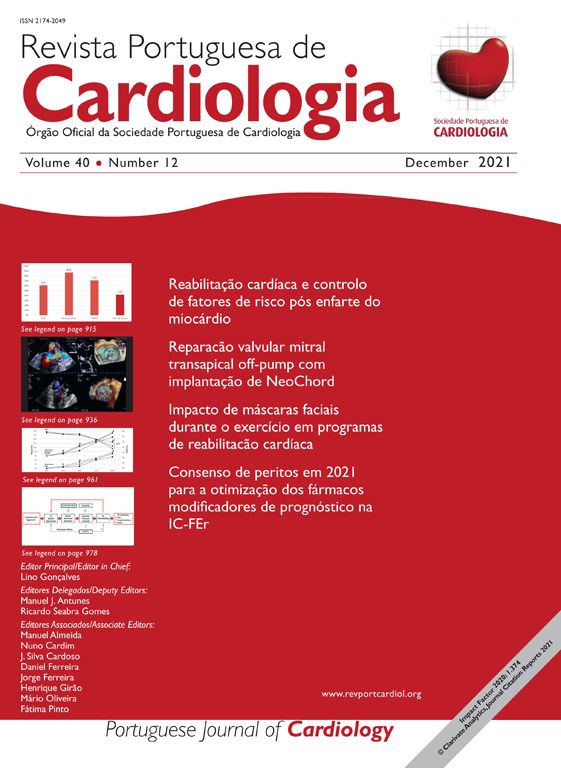Chronic thromboembolic pulmonary hypertension (CTEPH) is a rare complication of clinical and subclinical pulmonary embolism, characterized by unresolved fibro-thrombotic obstructions of the pulmonary arteries in combination with a secondary microvasculopathy of small vessels. Pulmonary endarterectomy (PEA) offers the best chance of symptomatic and prognostic improvement and is therefore the treatment of choice for the disease. Percutaneous balloon pulmonary angioplasty (BPA) and medical therapy have a potential role in patients unsuitable for PEA or with residual disease after surgery.
In this issue of the Portuguese Journal of Cardiology, Plácido et al.1 describe the clinical and surgical outcomes of 27 consecutive CTEPH patients who underwent PEA at an international surgical center, discuss pre and post-PEA management strategy, and conclude advocating for comparable assessment of outcomes at the recently-designated Portuguese PEA center.
First, it is important to highlight that all patients were diagnosed and medically managed in one national pulmonary hypertension (PH) referral center,2 thus potentially being offered full diagnostic investigation, an accurate PH differential diagnosis and state-of-the-art CTEPH management. Second, and despite reporting on a contemporary cohort of patients (2015-2019), both the mean time from symptom onset to diagnosis (3.3 years) and from diagnosis to surgery (2.6 years) are undesirably high. Not surprisingly, near to 90% of this population was in advanced functional class, more than half needed long-term oxygen therapy and 93% were on specific pulmonary vasodilator therapy before surgery. Although not associated with operability in the International CTEPH registry, longer diagnostic and treatment delays adversely impact disease morbidity and mortality.3–5 This can be presumably attributed to the development of a secondary microvasculopathy downstream of non-occluded pulmonary arteries and underscores the need for timely diagnosis and surgical treatment of CTEPH.
Pulmonary endarterectomy should be offered to all eligible patients with operable CTEPH. Appropriate assessment of operability is key to ensure that patients who have technically accessible disease are not misclassified and denied the benefits of PEA, and that patients who are ineligible due to comorbidities and/or would not benefit from surgery are correctly identified. However, as mentioned by Plácido et al., operability assessment is complex, cannot easily be standardized and depends on the experience of the surgeon. In view of this, the 2015 European Society of Cardiology/European Respiratory Society (ERS) Guidelines for the diagnosis and treatment of pulmonary hypertension,6 the 6th World Symposium on Pulmonary Hypertension proceedings7 and the ERS Statement on Chronic Thromboembolic Pulmonary Hypertension,8 all recommend that endarterectomy feasibility and patient eligibility should be discussed within a multidisciplinary team that includes an experienced PEA surgeon, a PH specialist, a BPA interventionist and a CTEPH-trained radiologist. When a patient is considered inoperable in specific settings (e.g., emerging sites, low-volume sites, participation in clinical trials), re-evaluation of operability by a second experienced center is recommended, so that patients with operable CTEPH are robustly identified. Remarkably, the authors report that 27 out of 29 consecutive patients were deemed operable and eligible, while registry data suggest that near a third of patients diagnosed with CTEPH did not proceed to PEA surgery in the past.3 The reported high operability rate is probably in line with the redefinition of the distal limits of endarterectomy as a result of advances in imaging techniques and surgical technique refinement in the high-volume experienced center where PEA was undertaken (Papworth Hospital in Cambridge is the national center for PEA in the United Kingdom).
All patients who underwent surgical treatment showed substantial improvement in clinical and invasive haemodynamic profile post-PEA. The benefit persisted for most patients in a median follow-up of 34 months, even though 56% of patients presented some degree of residual pulmonary hypertension after surgery. Importantly, and aligned with these positive surgical outcomes, 26% of patients were withdrawn from specific pulmonary vasodilator therapy and 48% weaned from oxygen therapy. Perioperative complications occurred in one fifth of the patients. However, no significant post-operative permanent morbidity or mortality were reported in this series. These surgical outcomes are consistent with prior reports from the International CTEPH registry and several other series.3,4,9
Even though there is no definition of successful outcome after PEA, CTEPH patients would expect to survive the operation without major morbidity and gain improved functional capacity and quality of life that is sustained to prolong lifetime. Experts have suggested that a successful outcome after PEA presumes in-hospital mortality <5% and three year survival of 90%, as well as improved functional class and quality of life.8 The benchmarks of postoperative mortality and three year survival were set by the International CTEPH registry published in 20119 and the New International CTEPH registry published in 2016.4
Similar to many other cardiac and thoracic surgical indications, PEA surgical outcomes are closely related to patient selection, waiting time from acceptance to surgery, meticulous surgical technique, and high-quality perioperative care. Experts from leading surgical centers have proposed a definition of expert surgical center which factors surgical mortality (30-day or in-hospital mortality <5%), ability to perform distal segmental-level endarterectomy and ability to offer all three modalities of treatment (PEA, BPA and medical therapy). Based on mortality data in small, intermediate, and large volume centers participating in the International CTEPH registry,9 it is also the experts view that PEA should only be performed at selected centers with a case volume of >50 procedures per year.7,10 Regarding surgical volume, one could argue that high surgical volume may not be attainable for smaller countries like Portugal, considering the low incidence of CTEPH. Furthermore, other small countries have reported single-center outcomes similar to high-volume international centers.11,12 It is important to note that for most centers, a learning curve effect has been clearly demonstrated, with higher in-hospital mortality and procedural complication rates being reported in the early phase of the learning curve, followed by a reduction in in-hospital mortality with increasing experience. Currently, and for a starting PEA program, clinical practice suggests systematic mentoring and specialized skills training for one year and experience of at least 50 procedures in a high-volume center, with the aim of aiding new PEA surgeons to negotiate the steep learning curve and achieve good outcomes.8
For nearly two decades, Portuguese CTEPH patients have been referred to different international PEA centers for surgery under a national health service sponsored program (Mobilidade Internacional de Doentes Portal da Mobilidade dos Doentes (dgs.pt)).13 The Royal Papworth Hospital in the UK, the Marie Lannelongue Hospital in France, the Kerckhoff Clinic Bad Nauheim in Germany and the Hospital Universitario 12 de Octubre in Spain are among the healthcare institutions that have operated on eligible CTEPH patients. Plácido et al.1 report for the first time on a cohort of 27 Portuguese patients undergoing PEA in the sole UK center offering PEA. Having performed more than 2000 operations since 1996, and carrying out 170-190 PEA operations per year, the Royal Papworth Hospital reports some of the best outcomes internationally.
Recently, the national health authorities designated a national reference center for PEA.2 It is of relevance, and at the current stage of the national PEA program, patients undergo risk stratification followed by triage, in order to identify complex cases who could benefit from PEA surgery in an international high-volume center. A national PEA center can potentially improve accessibility and reduce cost, among other indisputable advantages. Overcoming the administrative burden caused by complexities of referral abroad and the lengthy approval process may reduce time on the waiting list and allow for timely surgery. Accessibility could also improve in those cases when fear of out-of-pocket expenses, lack of information and apprehension about the process, as well as insufficient linguistic fluency in a foreign language negatively impact the decision of a patient to be referred for surgery abroad. If equivalent outcomes are achieved one can also argue that the total cost for hospitalization, surgery, physician fees, air transportation, and hotel expenses abroad are far more likely to be more than the cost of the procedure in a national center. Nevertheless, cost reduction might be hindered by the cost of long-term PH-specific medical therapies in patients that present significant residual disease.
Whether a national reference center for PEA can produce equivalent outcomes in the same risk category population requires careful assessment. Measurement and monitoring of outcomes is essential to ensure that the performance of the national PEA program is aligned with its intent and that resources are used efficiently and effectively.14 This assessment will also provide data to stakeholders and decision makers on the benefits of national versus outsourced CTEPH surgical care abroad. While the importance of assessing any surgical program outcomes is clear, the methodology of doing so is far more intricate. Validated metrics and high-quality data are crucial to rigorous decision making. Yet only recently a national PH registry was put in place that will allow data collection and characterization of the clinical course and outcomes of surgical and nonsurgical therapies for patients with CTEPH in the future.
The primary concern of physicians and patients considering CTEPH treatment strategies is the quality of care and patient outcomes. A PEA expert center offers optimal CTEPH assessment and treatment by a multidisciplinary team comprised of medical, surgical, and interventional physicians with relevant expertise in CTEPH. For the future, a major task will be to tailor the optimal treatment strategy to the individual CTEPH patient, but also to decide where it should be offered.
Conflicts of interestThe author has no conflicts of interest to declare.




